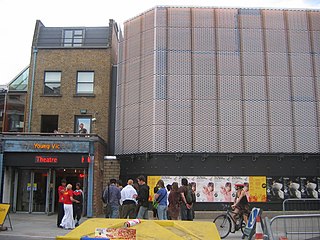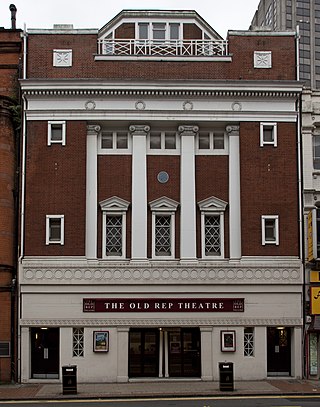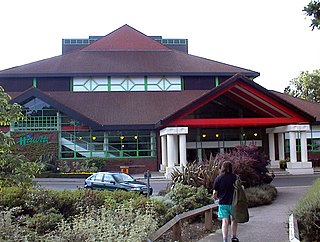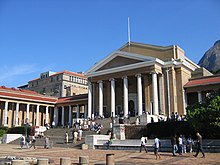
The Royal Shakespeare Company (RSC) is a major British theatre company, based in Stratford-upon-Avon, Warwickshire, England. The company employs over 1,000 staff and opens around 20 productions a year. The RSC plays regularly in London, Stratford-upon-Avon, and on tour across the UK and internationally.
The Kalamazoo Civic Theatre is a community theater company located in Kalamazoo, Michigan.

Sadler's Wells Theatre is a London performing arts venue, located in Rosebery Avenue, Islington. The present-day theatre is the sixth on the site. Sadler's Wells grew out of a late 17th-century pleasure garden and was opened as a theatre building in the 1680s.

The Young Vic Theatre is a performing arts venue located on The Cut, near the South Bank, in the London Borough of Lambeth.

A theater, or playhouse, is a structure where theatrical works, performing arts, and musical concerts are presented. The theater building serves to define the performance and audience spaces. The facility usually is organized to provide support areas for performers, the technical crew and the audience members, as well as the stage where the performance takes place.

The Old Rep is a Grade II listed theatre, located on Station Street in Birmingham, England. When it was constructed in 1913, it was the United Kingdom's first ever purpose-built repertory theatre. When built, it became the permanent home for Barry Jackson's newly formed Birmingham Repertory Company, which began life in 1911, born from his amateur theatre group, The Pilgrim Players, founded in 1907. Jackson funded the construction of the theatre and established a professional, resident company there, which soon became a major powerhouse within the British theatre due to its innovative stagings of the works of both Shakespeare and George Bernard Shaw, resulting in some considering it to be Birmingham’s answer to The Old Vic.

The Citizens Theatre, in what was the Royal Princess's Theatre, is the creation of James Bridie and playwright in residence Paul Vincent Carroll is based in Glasgow, Scotland, as a principal producing theatre. The theatre includes a 500-seat Main Auditorium, and has also included various studio theatres over time.

The National Centre for the Performing Arts (NCPA) is a multi-venue, multi-purpose cultural centre in Mumbai, India, which aims to promote and preserve India's heritage of music, dance, theatre, film, literature and photography. It also presents new and innovative work in the performing arts field.

The Hawth Theatre is an arts and entertainment complex located in 38 acres (150,000 m2) of woodland about 0.5 mi (800 m) from the town centre of the English town of Crawley. It is wholly owned by Crawley Borough Council and is currently operated by Parkwood Theatres.

The Theatre Royal, was an opera house and performance venue in Wexford Ireland which opened in 1832 and closed in 2005. It was the home of the annual Wexford Festival Opera, and has now been replaced by The National Opera House.

Canberra Theatre Centre (CTC), also known as the Canberra Theatre, is the Australian Capital Territory’s central performing arts venue and Australia's first performing arts centre, the first Australian Government initiated performing arts centre to be completed. It opened on 24 June 1965 with a gala performance by the Australian Ballet.

The Wolverhampton Grand Theatre, commonly known as The Grand, is a theatre located on Lichfield Street, Wolverhampton. The theatre was designed in 1894 by Architect Charles J. Phipps. It is a Grade II Listed Building with a seating capacity of 1200.

Theatre of United Kingdom plays an important part in British culture, and the countries that constitute the UK have had a vibrant tradition of theatre since the Renaissance with roots going back to the Roman occupation.

Audrey Sophia "Sophie" Harris was an English award winning theatre and opera costume and scenic designer.
Middlesbrough Theatre is a theatre in Middlesbrough, England, which was opened by Sir John Gielgud in 1957 and was one of the first new theatres built in England after the Second World War.

Bolton Little Theatre is a registered charity located at Hanover Street, Bolton BL1 4TG and has a small car park available. It was established in 1931. The theatre is a member of the Bolton Amateur Theatre Societies, The Little Theatre Guild of Great Britain, which it joined in 1947 and the Greater Manchester Drama Federation. Bolton is the envy of many towns as it has the largest amateur theatre network in the UK.

Royal & Derngate is a theatre complex in the Cultural Quarter of Northampton, England, consisting of the Royal Theatre, Derngate Theatre and the Northampton Filmhouse. The Royal was built by theatre architect Charles J. Phipps and opened in 1884. Ninety-nine years later in 1983, Derngate, designed by RHWL, was built to the rear of the Royal. Whilst the two theatres were physically linked, they did not combine organisations until a formal merger in 1999; they are run by the Northampton Theatres Trust. The Royal Theatre, established as a producing house, has a capacity of 450 seats and since 1976 has been designated a Grade II listed building; Derngate Theatre seats a maximum of 1,200 and is a multi-purpose space in which the auditorium can be configured for a variety of events including theatre, opera, live music, dance, fashion and sports. The Northampton Filmhouse, an independent cinema built to the side of the complex, opened in 2013.
The Little Theatre in the Adelphi was a 250-seat theatre in London, in a site to the south of the Strand. It was opened in 1910, damaged in a German air raid in the First World War and rebuilt in 1919–20. German bombs again hit the theatre in 1941 so severely damaging it that it remained empty until it was demolished in 1949.
The Gateway Theatre was a Category C listed building in Edinburgh, Scotland, situated on Elm Row at the top of Leith Walk.
















